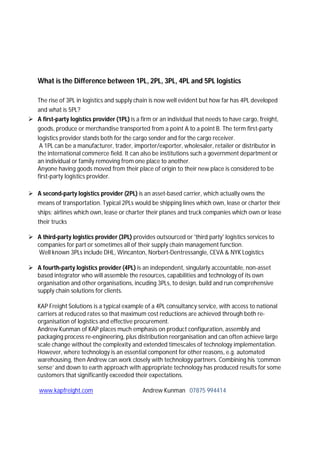
What Is a 3PL
- 1. What is the Difference between 1PL, 2PL, 3PL, 4PL and 5PL logistics The rise of 3PL in logistics and supply chain is now well evident but how far has 4PL developed and what is 5PL? A first-party logistics provider (1PL) is a firm or an individual that needs to have cargo, freight, goods, produce or merchandise transported from a point A to a point B. The term first-party logistics provider stands both for the cargo sender and for the cargo receiver. A 1PL can be a manufacturer, trader, importer/exporter, wholesaler, retailer or distributor in the international commerce field. It can also be institutions such a government department or an individual or family removing from one place to another. Anyone having goods moved from their place of origin to their new place is considered to be first-party logistics provider. A second-party logistics provider (2PL) is an asset-based carrier, which actually owns the means of transportation. Typical 2PLs would be shipping lines which own, lease or charter their ships; airlines which own, lease or charter their planes and truck companies which own or lease their trucks A third-party logistics provider (3PL) provides outsourced or 'third party' logistics services to companies for part or sometimes all of their supply chain management function. Well known 3PLs include DHL, Wincanton, Norbert-Dentressangle, CEVA & NYK Logistics A fourth-party logistics provider (4PL) is an independent, singularly accountable, non-asset based integrator who will assemble the resources, capabilities and technology of its own organisation and other organisations, incuding 3PLs, to design, build and run comprehensive supply chain solutions for clients. KAP Freight Solutions is a typical example of a 4PL consultancy service, with access to national carriers at reduced rates so that maximum cost reductions are achieved through both re- organisation of logistics and effective procurement. Andrew Kunman of KAP places much emphasis on product configuration, assembly and packaging process re-engineering, plus distribution reorganisation and can often achieve large scale change without the complexity and extended timescales of technology implementation. However, where technology is an essential component for other reasons, e.g. automated warehousing, then Andrew can work closely with technology partners. Combining his ‘common sense’ and down to earth approach with appropriate technology has produced results for some customers that significantly exceeded their expectations. www.kapfreight.com Andrew Kunman 07875 994414
- 2. A fifth party logistics provider (5PL) will aggregate the demands of the 3PL and others into bulk volume for negotiating more favourable rates with airlines and shipping companies. Non asset based, it will work seamlessly across all disciplines. The central ethos of 5PL is its commitment to collaboration and to obtaining a higher degree of resource utilisation in order to achieve savings and open up opportunities to secure the best possible solution at minimum cost/carbon etc., 5PL Ltd. has been active in this role for over 18 months and has experienced how the 5PL role is developing into something approaching a virtual wholesaler and is exploiting all manner of opportunities. This is especially so for SME, who are able to reap higher profitability from selling into premium and export markets whilst retaining their core business with multiples and mainstream wholesalers. Jeff Screeton (co-founder of 5PL Ltd.) says experience has shown that the role of “control tower” is really just the starting point. This model is a very exciting development because its boundaries are very flexible and the opportunities for helping companies realise their potential on the domestic and global stages are virtually limitless. www.5pl-uk.com Jeff Screeton 07799 410050
